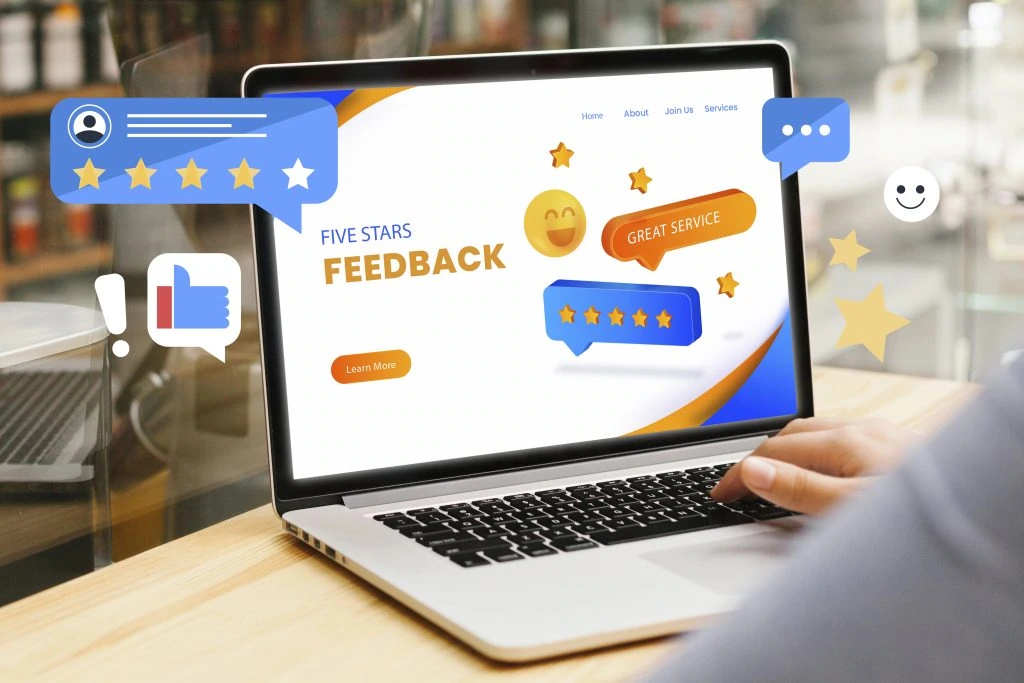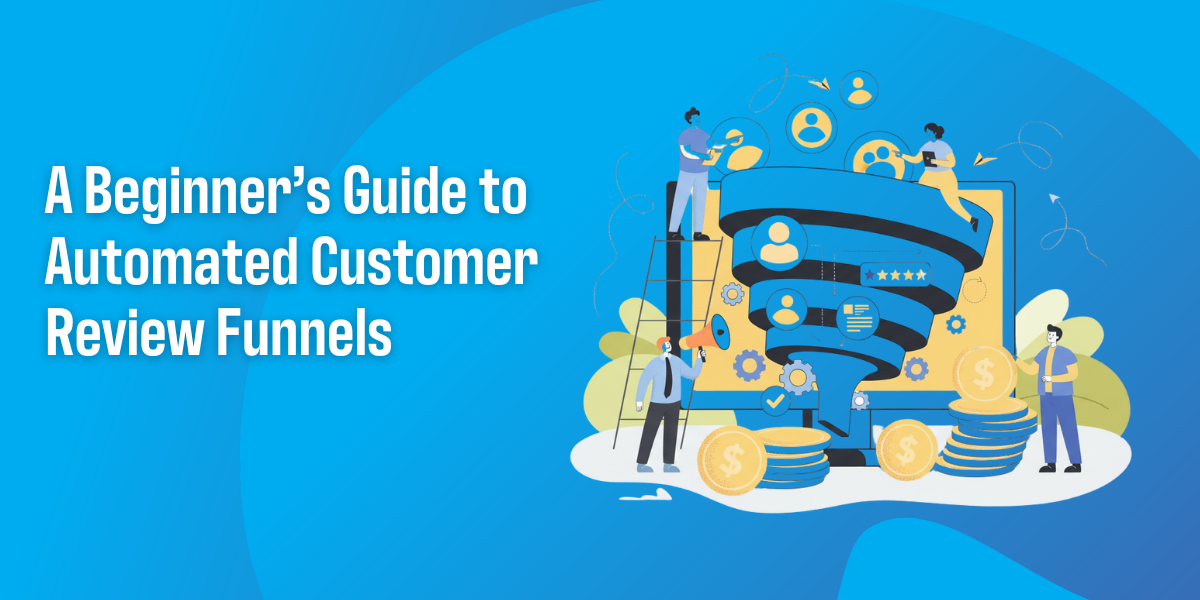In today’s digital world, online reviews have become one of the most powerful factors in a customer’s decision-making process. They shape perceptions, influence trust, and often determine whether someone chooses your business over a competitor. In fact, most buyers check reviews before making a purchase; meaning your reputation is often decided before you even speak to a customer.
For business owners, the challenge isn’t knowing that reviews are important, it’s finding the time and consistency to collect them. Manually asking every customer for feedback can be exhausting, and it often leads to missed opportunities. That’s where automated customer review funnels come in.
An automated review funnel is a system that requests, collects, and manages reviews on your behalf. Instead of chasing customers one by one, you set up a process that runs in the background; prompting satisfied customers to share their experiences publicly while giving unhappy ones a private channel to voice concerns. The result is more positive reviews, stronger customer relationships, and fewer damaging surprises.
Why Automate the Review Process

Save Time and Reduce Manual Work
Instead of sending review requests one by one, an automated funnel triggers messages at the right moment, such as after a purchase or service appointment. This frees up your team from repetitive follow-ups and ensures no customer slips through the cracks. Automation lets you scale review collections without sacrificing quality.
Improve Review Volume and Consistency
Search engines reward businesses with a steady stream of fresh reviews. A few reviews every month are far more powerful than a large batch once in a while. Automated funnels keep the flow consistent by sending requests on autopilot. This helps you maintain visibility in search results and build credibility with potential customers.
Increase Response Rates
Customers are more likely to leave a review when they are asked at the right time. Automated systems can be programmed to reach out when the experience is still fresh, such as a few hours after a meal, a next-day delivery confirmation, or shortly after a successful service call. This timing boosts the likelihood of capturing genuine, positive feedback.
Protect Your Online Reputation
Automation does more than just collect reviews. A well-designed funnel can filter responses, guiding satisfied customers to public review platforms while directing unhappy customers to a private feedback channel. This approach helps you resolve issues quickly and prevents negative experiences from becoming public complaints.
Support Business Growth and SEO
Every review contributes to stronger local SEO. More positive reviews mean better rankings in Google search and Maps, which drives more clicks, calls, and visits. Beyond SEO, reviews also serve as powerful social proof on your website, in ads, and across social media. Automation ensures that you always have a fresh supply of customer stories to share.
In short, automating your review process gives you more reviews, better feedback, stronger rankings, and happier customers; all while saving valuable time.
Building Blocks of an Effective Review Funnel
An automated customer review funnel works best when it is built on a few essential components. Think of these as the foundation that ensures your system runs smoothly and delivers consistent results.
Identify the Right Customer Touchpoints
The first step is knowing when to ask for a review. Timing matters. Common touchpoints include:
- After purchase: Send a request once an order has been delivered or completed.
- After service: Reach out following an appointment, installation, or consultation.
- Follow-up interactions: When a customer renews a subscription, uses support successfully, or engages with your brand in a positive way.
By aligning review requests with these natural moments, you increase the chances of receiving thoughtful feedback.
Craft Clear and Personalized Messaging
Your message should be short, friendly, and direct. Personalization makes a big difference; including the customer’s name, the product they purchased, or the service they received shows that the request is genuine. For example:
“Hi Sarah, thank you for choosing Javalogix. We’d love to hear how your recent service went. Your feedback helps us improve and helps others make confident decisions.”
Use Multiple Channels for Outreach
Not every customer prefers the same communication method. The most effective review funnels use a mix of channels, such as:
- Email: Ideal for detailed requests and branded templates.
- SMS: Short, direct, and great for higher response rates.
- QR codes: Perfect for in-person businesses like restaurants or salons.
- In-app notifications: Useful for software and subscription services.
Offering multiple ways to leave a review ensures you meet customers where they are most comfortable.
Segment Customers for Better Results
Not all customers should receive the same follow-up. Segmentation allows you to customize your funnel:
- Happy customers: Direct them to public platforms like Google or Yelp.
- Neutral or unhappy customers: Send them to a private survey or support team for resolution.
- Repeat customers: Encourage them to share multiple reviews across different products or services.
This approach increases positive reviews online while also turning negative feedback into opportunities for improvement.
Automate Follow-Ups and Reminders
One request is often not enough. A polite reminder can double your review volume. Automated funnels can be programmed to send a second message if the first is ignored, ensuring you maximize responses without overwhelming your customers.
Step-by-Step Guide to Setting Up an Automated Review Funnel

Building an automated review funnel may sound complicated, but once you break it down into steps, the process is straightforward. Here is a practical guide you can follow to create a system that consistently collects customer feedback and boosts your online reputation.
Step 1: Choose the Right Review Funnel Tool
Start by selecting software that fits your business size and goals. Popular tools include Podium, Birdeye, Trustpilot, Yotpo, and NiceJob. Look for features like email and SMS automation, CRM integrations, and reporting dashboards. Make sure the tool integrates with the platforms your customers already use, such as Google, Yelp, or Facebook.
Step 2: Connect Your Customer Database
Automation works best when it has access to accurate customer information. Sync your review funnel tool with your CRM, point-of-sale system, or booking software. This ensures that requests are triggered automatically after purchases, appointments, or other key interactions.
Step 3: Create Review Request Templates
Craft messages that are short, friendly, and personalized. Write both email and SMS versions so you can reach customers across multiple channels. For example:
Email:
“Hi Mike, thank you for choosing Javalogix. We would love to hear about your experience. Please share your feedback by clicking the link below.”
SMS:
“Thanks for your recent visit to Javalogix. Could you take 30 seconds to leave us a quick review?”
Templates save time and keep your requests consistent.
Step 4: Define Triggers and Timing
Set rules for when your messages are sent. Timing is critical for high response rates. A restaurant might trigger a request a few hours after dining. A contractor could send one the day after completing a project. By aligning timing with customer experience, you make it easy for customers to provide feedback while the interaction is still fresh in their minds.
Step 5: Add a Feedback Filter
Direct positive responses to public review platforms and route negative feedback to a private survey or support form. This gives you a chance to resolve issues quickly while protecting your online reputation. Most review funnel tools allow you to build this filter into the process automatically.
Step 6: Automate Follow-Ups
Not every customer will respond to the first request. Add a reminder sequence that sends a second message after a few days if no review has been left. Be polite and professional, making it clear that their opinion matters. Automated reminders can significantly increase your overall review volume.
Step 7: Monitor and Analyze Performance
Once your funnel is live, track metrics such as response rates, review volume, and star ratings. Most platforms provide dashboards with insights into how well your funnel is working. Use this data to refine your messaging, timing, and channels for even better results.
Review Funnel Tools: What’s Available in 2025
Choosing the right tool is one of the most important decisions for your review funnel. The wrong choice can lead to headaches with integration, poor user experience, or wasted money. Here’s a guide to the features to look for in 2025, plus a comparison of leading platforms.

Key Features to Look For
When evaluating review funnel / review management / reputation tools, these features make a real difference:
| Feature | Why It Matters | What to Test |
| Multi-channel request support (email, SMS, in-app) | You reach customers by their preferred method | Try triggering from both SMS and email and see response rates |
| Integrations & API access | Your funnel needs to work with your CRM, order system, booking software | Check if it integrates with your stack (Shopify, Salesforce, etc.) |
| Review filtering / feedback routing | To separate positive and negative responses | Ability to route unhappy feedback away from public sites |
| Review monitoring & alerts | To respond quickly | Alerts when new reviews appear (across multiple platforms) |
| Analytics & reporting | To optimize the funnel | Metrics like request response rates, star trend over time |
| Review display / widgets | To showcase reviews on your site | Ability to embed or dynamically show reviews |
| Scalability / multi-location support | Important if your business has branches | Check how it handles multiple branches or locations |
| Compliance, fraud detection, review moderation | To stay within platform rules and avoid fake reviews | Tools to flag suspicious ones, control moderation |
Top Tools in 2025: Comparison & Use Cases
Here are some of the standout tools for automated review funnels in 2025, with pros, cons, and ideal use cases. Data based on recent reviews and comparisons.
| Tool | Best For / Strength | Things to Watch / Limitations |
| Birdeye | Local businesses with many touchpoints (calls, SMS, email) | Can get pricey as volume scales |
| Podium | Brick-and-mortar businesses, home services | SMS cost may add up |
| Yotpo | E-commerce brands, product reviews | Strong in showing reviews on product pages |
| ReviewTrackers | Businesses that want strong monitoring across many review sites | Some features locked behind higher tiers |
| Reviewflowz | SaaS and tech companies wanting testimonial management + review generation | Might be overkill for very small local shops |
| Housecall Pro Review Management | Service businesses (plumbers, HVAC, contractors) | Best when you already use Housecall Pro for scheduling |
| HiFiveStar | Simple, affordable review generation for small businesses | Fewer advanced features compared to enterprise tools |
Best Practices for Automated Review Funnels in 2025
Setting up a review funnel is one thing. Running it effectively is another. To get the most out of your system, you need clear practices that keep reviews flowing, protect your reputation, and make your efforts sustainable. Here are the top strategies for 2025.
Ask at the Right Time
Timing is critical. A request sent too early may feel pushy, while one sent too late risks being ignored. For service businesses, the best time is within 24 hours of the job being completed. For e-commerce, send requests once the customer has received and used the product.
Personalize Your Requests
Generic review requests often get overlooked. Use the customer’s name, reference the specific service or product, and keep the tone conversational. A personalized message increases response rates and makes the customer feel valued.
Keep the Process Simple
Every extra step reduces the chance of getting a review. Make it one click to leave feedback on Google, Yelp, or your platform of choice. Minimize forms, logins, or redirects.
Balance Public and Private Feedback
A good review funnel routes unhappy customers to a private channel. This prevents negative feedback from being posted publicly while giving you a chance to resolve the issue. At the same time, make it easy for satisfied customers to go straight to a public platform.
Monitor and Respond Quickly
Automation should not mean ignoring feedback. Respond to both positive and negative reviews within 24 to 48 hours. Quick replies show you care and can often turn a neutral experience into a positive one.
Stay Compliant
Platforms like Google and Yelp have strict guidelines against review gating or incentivizing reviews. Follow the rules to protect your reputation and avoid penalties. Always aim for authentic, voluntary feedback.
Measure and Adjust
Track your funnel metrics: open rates, response rates, and the percentage of reviews that end up public. Use these numbers to identify weak points and refine your process over time.
Build a Stronger Reputation with Automated Review Funnels
Customer reviews have become one of the most important signals of trust and credibility in today’s digital marketplace. An automated review funnel helps you collect feedback consistently, amplify positive experiences, and address concerns before they damage your reputation. When set up correctly, it works in the background to bring in fresh reviews that boost your search visibility, attract new customers, and strengthen long-term loyalty.
The key is to follow best practices, avoid common mistakes, and choose the right tools that fit your business goals. Whether you run a local service, an e-commerce store, or a growing brand, automation can take the stress out of review management and turn customer feedback into one of your most valuable growth assets.
At Javalogix, we help businesses build smarter systems for marketing, automation, and online growth. If you are ready to set up a customer review funnel that works around the clock and drives real results, our team can guide you through every step.
Start building your automated review funnel today with Javalogix and turn satisfied customers into your strongest advocates.
Frequently Asked Questions
What is an automated customer review funnel?
An automated customer review funnel is a system that helps businesses collect and manage reviews from customers automatically. It guides customers through the review process after they’ve made a purchase, making it easier for them to share their experiences.
Why are customer reviews important for my business?
Customer reviews are important because they build trust and credibility for your business. Positive reviews can attract new customers, improve your online reputation, and help you stand out from competitors.
How does automation make collecting reviews easier?
Automation streamlines the review process by sending reminders and follow-ups to customers without requiring manual effort. This saves time and ensures that more customers are prompted to leave feedback.
Can I customize the review requests sent to customers?
Yes, most automated review funnel systems allow you to customize the messages and timing of the requests. This way, you can align the review requests with your brand voice and customer journey.
What types of businesses can benefit from using a review funnel?
Virtually any business can benefit from using a review funnel, including online stores, service providers, restaurants, and more. If you want to enhance your online presence and gather customer feedback, this system can help.
TL;DR Automated customer review funnels are essential for collecting feedback effectively and boosting trust, conversions, and SEO. These funnels streamline the review process through automated requests, leading to higher response rates and consistent outreach. Key components include touchpoints, personalization, and tool selection. Avoid pitfalls like over-automation and poor timing, while leveraging metrics to measure success. With practical examples and advanced strategies, this guide provides beginners and experienced marketers with the tools needed to enhance their review strategies.

